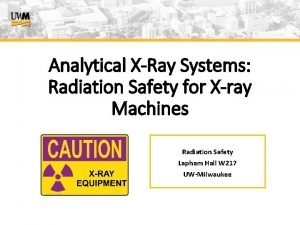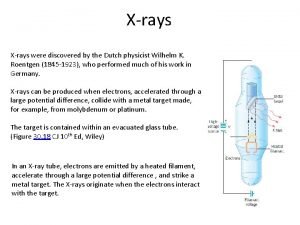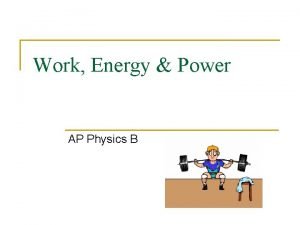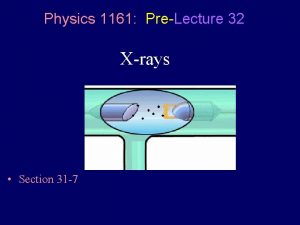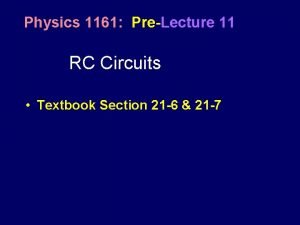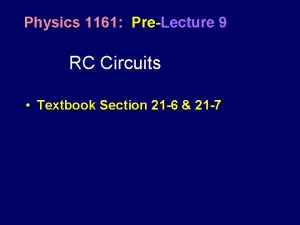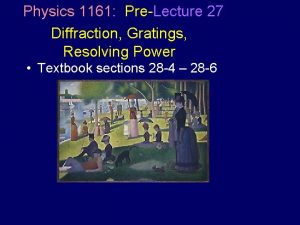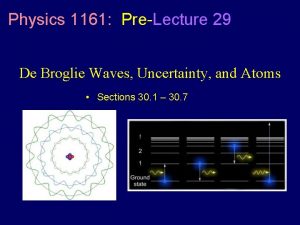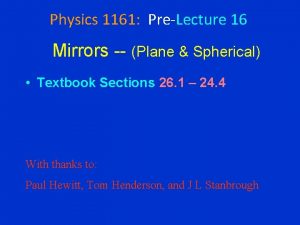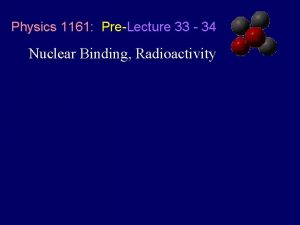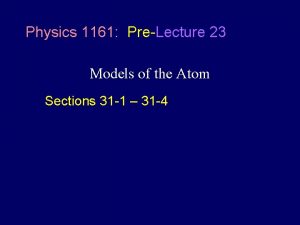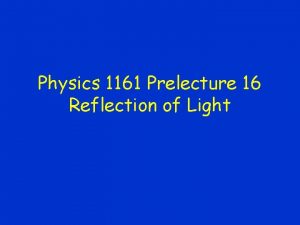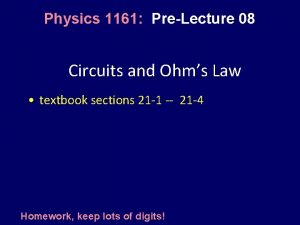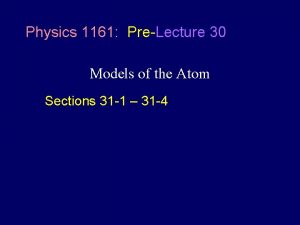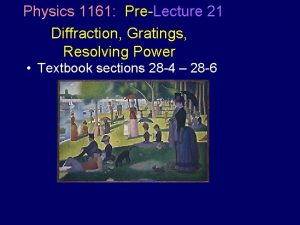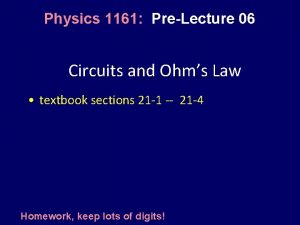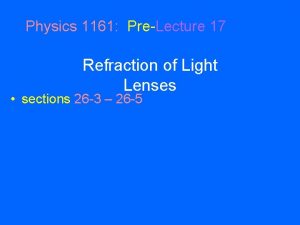Physics 1161 PreLecture 24 Xrays Section 31 7















- Slides: 15

Physics 1161: Pre-Lecture 24 X-rays • Section 31 -7

X-Rays Photons with energy in approx range 100 e. V to 100, 000 e. V. This large energy means they go right through you (except for your bones). What are the wavelengths? . 01 nm to 10 nm

X-Ray Production How do you produce 100 e. V photons? • Black Body Radiation – Would require temperature over 10 times hotter than surface of sun • Excitation of outer electrons – Typically have energy around 10 e. V • Radioactive Decays – Hard to turn on/off

Electron Tubes • Accelerate an electron through a voltage difference to give it some energy. . . An electron is accelerated through a potential difference of 70, 000 V. How much energy does it emerge with? Recall from Lecture 3: U = q. V KE = U = (1 e-) (70, 000 V) = 70, 000 e. V = 1. 6 x 10 -19 C U of voltage gap becomes K. E. for electron. = 11. 2 x 10 -14 J

From Electrons to X-Rays • Now take these high energy electrons (up to 100, 000 e. V) and slam them into heavy atoms - any element. • 2 kinds of X-Rays are produced: – “Bremsstrahlung” – “Characteristic”

Bremsstrahlung X-Rays • Electron hits atom and slows down, losing kinetic energy. – Energy emitted as photon • Electron hitting atom makes many photons (X-Rays), all with different energy. – Many different wavelengths. intensity • If all of electron’s energy is lost to a single photon, photon has maximum energy (minimum wavelength). – Minimum X-Ray wavelength = o.

Bremsstrahlung X-Rays • Electron hits atom and slows down, losing kinetic energy. – Energy emitted as photon • Electron hitting atom makes many photons (X-Rays), all with different energy. – Many different wavelengths. intensity 0 • If all of electron’s energy is lost to a single photon, photon has maximum energy (minimum wavelength). – Minimum X-Ray wavelength = o.

Characteristic X-Rays Electron knocks one of the two K shell (ground state) electrons out of an atom. L (n=2) or higher shell electron falls down to K shell (ground state) and x-ray photon is emitted e- e- e- L shell (n=2) Characteristic x-ray nomenclature e- e- K shell (n=1) e(high energy electron) n=1 n=2 n=3 “K shell” “L shell” “M shell”

Characteristic X-Rays Electron knocks one of the two K shell (ground state) electrons out of an atom. L (n=2) or higher shell electron falls down to K shell (ground state) and x-ray photon is emitted e- e- e- L shell (n=2) eejected electron Characteristic x-ray nomenclature ee- e- K shell (n=1) n=1 n=2 n=3 “K shell” “L shell” “M shell”

Characteristic X-Rays Electron knocks one of the two K shell (ground state) electrons out of an atom. L (n=2) or higher shell electron falls down to K shell (ground state) and x-ray photon is emitted e- e- e- L shell (n=2) L shell electron falls down e- e- K shell (n=1) Characteristic x-ray nomenclature n=1 n=2 n=3 “K shell” “L shell” “M shell” X-Ray photon emitted “K X-ray” (n=2 n=1 transition)

Kb X-Rays K X-rays come from n=2 What about n=3 n=1 transition? Not as likely, but possible. Produces Kb X-Rays! intensity Kb X-Rays are higher energy (lower ) than K. (and lower intensity) Kb K Different elements have different Characteristic X-Rays

Nuclear Physics A Z Nucleus = Protons+ Neutrons nucleons Z = proton number (atomic number) Gives chemical properties (and name) N = neutron number A = nucleon number (atomic mass number) Gives you mass density of element A=N+Z Periodic_Table

Strong Nuclear Force • Acts on Protons and Neutrons • Strong enough to overcome Coulomb repulsion • Acts over very short distances Two atoms don’t feel force

Strong Nuclear Force Hydrogen atom: Binding energy =13. 6 e. V (of electron to nucleus) Coulomb force proton electron proton neutron Simplest Nucleus: Deuteron=neutron+proton Very strong force Binding energy of deuteron = 2. 2 Mev! That’s around 200, 000 times bigger! or

# protons = # neutrons Pauli Principle - neutrons and protons have spin like electron, and thus ms= 1/2. Can get 4 nucleons into n=1 state. Energy will favor N=Z But protons repel one another (Coulomb Force) and when Z is large it becomes harder to put more protons into a nucleus without adding even more neutrons to provide more of the Strong Force. For this reason, in heavier nuclei N>Z. 7
 Rotating anode
Rotating anode Who discovered xrays
Who discovered xrays Jfk skull
Jfk skull How were xrays discovered
How were xrays discovered Why does it happen
Why does it happen University physics with modern physics fifteenth edition
University physics with modern physics fifteenth edition Physics ia rubric
Physics ia rubric Scattering cross section in nuclear physics
Scattering cross section in nuclear physics Cross sectional view
Cross sectional view Revolved view
Revolved view What symbol is commonly used for half-section view?
What symbol is commonly used for half-section view? What is the definition of chemical potential energy
What is the definition of chemical potential energy Study guide chapter 10 section 1 meiosis
Study guide chapter 10 section 1 meiosis Ap physics power
Ap physics power Power formula
Power formula Physics 03-06 impulse and momentum answer key
Physics 03-06 impulse and momentum answer key

